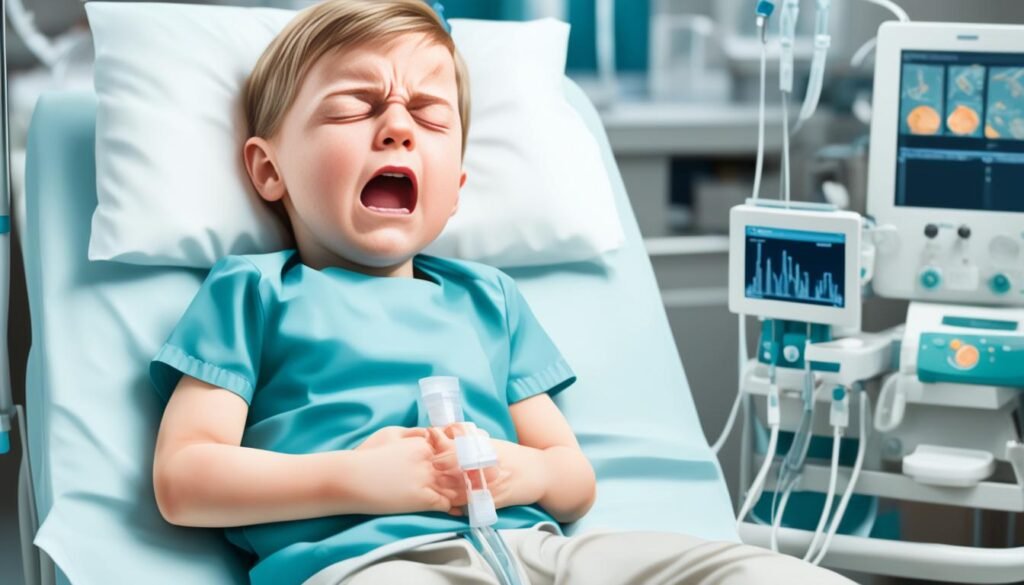If you have a child or teenager, knowing about Reye’s syndrome is critical. Reye’s syndrome mostly affects those under 18 after getting a viral illness. It can lead to liver and brain swelling, causing confusion, seizures, and even coma.
Symptoms of Reye’s syndrome appear a few days after a viral illness starts. It’s vital to diagnose early and treat fast. Without care, it can be fatal. It’s especially important to avoid giving children aspirin for pain or fever. Instead, use acetaminophen (Tylenol) or ibuprofen (Advil).
If vomiting, confusion, or serious symptoms follow a viral illness, get help right away. Early treatment can save lives and prevent brain damage. Understanding Reye’s syndrome and avoiding aspirin can keep your family safe.
Table of Contents
ToggleOverview of Reye’s Syndrome
Definition and Key Facts
Reye’s syndrome is a rare disorder that mostly harms kids and teens under 18. It shows fatty liver changes and sudden brain swelling. The exact cause is unknown, but doctors think it’s connected to using aspirin with certain viral illnesses.
These illnesses include the flu and chickenpox. Reye’s syndrome can be deadly, so it needs quick care.
Rarity and Affected Age Group
Reye’s syndrome affects mostly kids and teenagers, especially those aged 5 to 14. It’s very rare in babies and adults over 18. The syndrome is related to taking medicines like aspirin, especially in those under 16.

What Is Reye’s Syndrome
Reye’s syndrome is a rare disorder that affects kids and teenagers under 18. It leads to fatty changes in the liver and swelling of the brain. This happens during the recovery from viral infections like the flu or chickenpox. The main cause is not known for certain, but it’s linked to taking aspirin during these illnesses.
Reye’s syndrome might appear a few days after the first signs of a virus. Using aspirin seems to make the risk higher. That’s why it’s very important not to give aspirin to children or teenagers with viral infections. Doctors advise against it to prevent Reye’s syndrome.
Unfortunately, there’s no cure for Reye’s syndrome. But, doctors can focus on stopping brain damage. How well a person gets better just depends. Some fully recover, while others might have lasting brain issues. Getting treatment early is key to increasing the chance of survival.
Symptoms of Reye’s Syndrome
The signs of Reye’s syndrome often show up 3 to 5 days after getting a viral sickness. This could be simple things like the flu or chickenpox. It’s really important to know the early symptoms and when to get help. This helps get the right treatment early, which is key to fighting this rare but severe illness.
Initial Symptoms
At first, you might see diarrhea, fast breathing, throwing up, feeling very tired, and moving slower than usual. If a child under 2 shows these signs, it’s important to get them to a doctor right away. Even if these signs are not clear, early attention is crucial.
Additional Symptoms
Reye’s syndrome can get worse over time. The mild start might turn into being very moody, not making sense, or feeling weak in the arms and legs. It could lead to seizures, extreme fatigue, and not being fully awake. If any of these signs show, seek emergency medical help immediately.
When to Seek Medical Attention
If a child starts having seizures, faints, or keeps throwing up after being sick with the flu or chickenpox, don’t wait. Unusual sleepiness or sudden changes in behavior also signal something serious. Reye’s syndrome can be deadly if not treated fast.

Causes of Reye’s Syndrome
Experts are still not sure what exactly causes Reye’s syndrome. But, they think that taking aspirin while having certain viral illnesses might lead to it. For example, when someone has the flu or chickenpox and uses aspirin, they might get Reye’s syndrome. Certain metabolic disorders, like MCAD deficiency, could also be a cause. These are problems with how the body uses fats.
Link with Aspirin Use
Research shows that using aspirin during viral infections is strongly linked to Reye’s syndrome. This is why doctors advise against giving aspirin to kids. Aspirin might not be safe for children because of this connection.
Underlying Metabolic Disorders
Some metabolic disorders can make people more likely to get Reye’s syndrome. These disorders make it hard for the body to use fats properly. If doctors screen newborns for these disorders, they can spot kids who might be at higher risk for Reye’s syndrome. This early detection can be crucial.
Viral Infections Associated with Reye’s Syndrome
Getting a viral illness, like the flu, often leads to Reye’s syndrome. Signs of Reye’s syndrome usually show up 3 to 5 days after a viral infection starts. While some toxins can cause symptoms like Reye’s syndrome, they are not the real cause.
Risk Factors for Reye’s Syndrome
Many things can make a child more likely to get Reye’s syndrome. The main ones are:
- Taking aspirin for a virus, like the flu, chickenpox, or a breathing infection.
- Having a special health issue like a problem with breaking down fats or using energy.
Reye’s syndrome hits kids and teens hardest, usually between 5 and 14 years. It doesn’t happen often in babies under 1 or people older than 18. Using aspirin, like in teenagers, has a strong link to this disease.
Kids who have rare genetic problems, like MCADD, might also face more risk. This is especially if they also have a viral sickness and take aspirin.

Diagnosing Reye’s syndrome can be tricky, leading to slow treatment. But, more studies and joining clinical tests can make care better for those with this illness.
Complications of Reye’s Syndrome
Reye’s syndrome brings severe, life-threatening complications if not quickly treated. The main issues are liver failure, brain swelling, and high brain pressure.
It often leads to liver failure, which causes a toxic buildup and harms body function. This worsens brain swelling and pressure, key problems in this syndrome.
The brain’s high pressure can cause seizures, coma, and fatal outcomes. If someone has seizures or faints, they need medical help right away.
Though many with Reye’s syndrome survive, they may face lasting brain damage. This damage depends on the level and length of brain swelling.

If not treated quickly and aggressively, Reye’s syndrome can be deadly. Recognizing symptoms early and seeking medical help fast is critical. It can greatly improve the chances of survival.
Diagnosis of Reye’s Syndrome
Diagnosing Reye’s syndrome early is key. Quick recognition and treatment are vital to lower the risk of life-threatening issues. Doctors look at symptoms, test results, and rule out other causes to diagnose Reye’s.
Clinical Criteria
The CDC has set specific clinical criteria for Reye’s syndrome. This includes brain dysfunction with consciousness changes. Also, liver problems like high liver enzymes and ammonia levels are checked.
Laboratory Findings
Laboratory tests are important in diagnosing Reye’s syndrome. Tests of spinal fluid can find metabolic disorders. A liver biopsy looks for fat changes in the liver. The diagnosis is not by one test but by overall symptoms and test results.
Diagnosing Reye’s syndrome usually happens in an emergency. Symptoms like seizures need quick medical attention. This speeds up the chance of getting better.
Treatment and Management
The treatment focuses on supportive care. It targets the metabolic issues and rising pressure inside the brain. These problems can happen with Reye’s syndrome.
Supportive Care
Care includes central venous access setup, airway support, and a urine monitor. This monitoring happens in a very careful way in an intensive care unit.
Correcting Metabolic Abnormalities
The goal is to fix issues like low blood sugar, acidosis, and high ammonia. Treatments might use dextrose fluids plus sodium bicarbonate. They might also use medicines like phenylacetate-sodium benzoate to help with these problems.
Reducing Intracranial Pressure
To lower the brain’s pressure, some steps are taken. Patients might have their head raised and their fever controlled. Diuretics, like furosemide, could be used. For severe cases, mannitol or hypertonic saline might be needed to decrease pressure.
Reye’s Syndrome Prevention
It’s key not to give aspirin to kids or teens, especially if they have the flu or chickenpox. Use acetaminophen or ibuprofen for fever and pain instead. Also, newborn screening for metabolic disorders can spot kids more likely to get Reye’s syndrome.
Avoiding Aspirin in Children
Doctors say avoid aspirin in kids and teens because it can lead to Reye’s syndrome. Use acetaminophen or ibuprofen for fever and pain in viral illnesses. This helps lessen the risk of a severe outcome.
Newborn Screening for Metabolic Disorders
Newborn screening for metabolic disorders finds kids more at risk of Reye’s syndrome, like those with fatty acid oxidation disorders. It’s important because it lets you take steps early to avoid Reye’s syndrome during viral infections.
Vaccination Against Viral Illnesses
Make sure your child gets vaccines, like the influenza and chickenpox vaccines, to avoid the illnesses linked to Reye’s syndrome. Lowering the risk of these viral infections is a big step in avoiding this dangerous condition.
Epidemiology and Incidence
Reye’s syndrome is a rare condition, with less than 2 cases reported each year in the US since 1994. The real count might be higher, though. This is because reporting it is no longer a must. The peak age for getting it is between 5 and 14 years.
Historical Trends
Before, from 1979 to 1980, there were 555 cases in the US. This was a big worry for public health back then.
Impact of Public Health Warnings
In the 1980s, when people learned about aspirin causing Reye’s syndrome, cases dropped a lot. This happened in the US, the UK, and France. The warnings really worked. They made people around the world more aware.
Prognosis and Outcomes
The prognosis for Reye’s syndrome can vary. It is a serious condition that can be life-threatening. Luckily, most kids and teens who get it live. But, some may have brain damage. This can happen if not treated early.
It’s very important to spot Reye’s syndrome early. Then, start strong treatment right away. This helps lower the risk of dangerous problems like brain swelling. It also cuts the chances of seizures and organ failure.
The prognosis for Reye’s syndrome depends on a few things. How bad the illness is, the child’s age, and getting help quickly matter a lot. Early on, when found and treated soon, kids may heal fully without ongoing problems.
Yet, if the illness gets very severe, it could lead to serious setbacks. These might include lasting brain damage or even death. That’s why acting fast and treating it seriously is key.
Related Disorders
Reye’s syndrome is a rare disorder, but its signs often look like other problems. For instance, it shares some symptoms with OTC deficiency and fatty acid oxidation disorders. Recognizing these similarities is key to diagnosing and treating patients.
Ornithine Transcarbamylase Deficiency
OTC deficiency is another rare problem that affects how the body deals with toxins. It leads to high levels of ammonia, which can cause vomiting and confusion. Sometimes it happens when someone sick takes aspirin. This makes finding and treating OTC deficiency vital, especially if patients face stress from an illness.
People with OTC deficiency might show signs similar to Reye’s syndrome. This often happens if they use aspirin while sick. So, spotting and dealing with OTC deficiency early can help prevent this.
Fatty Acid Oxidation Disorders
Fatty acid oxidation disorders, like MCAD deficiency, can also look like Reye’s syndrome. These issues stop the body from using fats properly, leading to dangerous substances in the body. These can harm the liver and brain, especially under stress.
Testing newborns for these disorders is crucial. It helps spot those at higher risk for Reye’s syndrome. This is especially important if the child gets sick and takes aspirin.
Conclusion
Reye’s syndrome is a rare but serious condition. It mostly affects children and teenagers after they have the flu or chickenpox. Although we don’t know the exact cause, using aspirin during these illnesses can lead to Reye’s syndrome. It’s vital to spot the symptoms early, avoid aspirin, and get quick, aggressive medical help. Doing this can make the chances of severe problems lower.
Thanks to ongoing efforts and better public health, the number of Reye’s syndrome cases has dropped. The National Institutes of Health notes that it’s now a rare condition, with less than 2 cases yearly in the U.S. since 1994. This achievement is mainly because people have stopped giving aspirin to kids. This change also decreased the number of cases in countries like the United Kingdom.
But, we still need to be careful, especially for children with certain health issues that could make them more at risk. By knowing the risk factors, spotting early signs, and taking steps to prevent it, you can protect your child’s health. This is important, especially if they get a viral illness.
FAQ
What is Reye’s syndrome?
Reye’s syndrome is a rare but serious condition. It causes liver and brain swelling. It affects children and teenagers after viral infections like the flu or chickenpox.
What are the symptoms of Reye’s syndrome?
Symptoms include confusion, seizures, and loss of consciousness. They need emergency care. Without quick treatment, Reye’s syndrome can be deadly.
What causes Reye’s syndrome?
The cause of Reye’s syndrome isn’t fully known. But, it’s linked to using aspirin during viral illnesses. The flu or chickenpox are common triggers.
How is Reye’s syndrome treated?
Treating Reye’s syndrome is mainly about support. It needs intense care and close watch. Doctors may work on metabolic issues and lower brain pressure to help.
How can Reye’s syndrome be prevented?
Avoid aspirin in kids or teens with viral illnesses to prevent Reye’s syndrome. Use safer drugs like acetaminophen or ibuprofen for fever and pain.
What is the prognosis for Reye’s syndrome?
Thanks to modern care, most patients survive Reye’s syndrome. There might be some brain damage. But, without treatment, it can be fatal in days.
What are some disorders related to Reye’s syndrome?
Reye’s syndrome shares symptoms with some metabolic disorders. These include ornithine transcarbamylase (OTC) deficiency and fatty acid oxidation disorders.
Source Links
- https://www.mayoclinic.org/diseases-conditions/reyes-syndrome/symptoms-causes/syc-20377255
- https://rarediseases.org/rare-diseases/reye-syndrome/
- https://www.ninds.nih.gov/health-information/disorders/reyes-syndrome
- https://www.nhs.uk/conditions/reyes-syndrome/
- https://www.webmd.com/children/what-is-reye-syndrome
- https://www.mayoclinic.org/diseases-conditions/reyes-syndrome/diagnosis-treatment/drc-20377259
- https://emedicine.medscape.com/article/803683-treatment
- https://emedicine.medscape.com/article/803683-overview
- https://www.sciencedirect.com/topics/medicine-and-dentistry/reye-syndrome
- https://www.ncbi.nlm.nih.gov/books/NBK526101/
About The Author

This article is medically reviewed by Dr. Chandril Chugh, Board-Certified Neurologist, providing expert insights and reliable health information.
Dr. Chandril Chugh is a U.S.-trained neurologist with over a decade of experience. Known for his compassionate care, he specializes in treating neurological conditions such as migraines, epilepsy, and Parkinson’s disease. Dr. Chugh is highly regarded for his patient-centered approach and dedication to providing personalized care.
→ Book a consultation to discover which remedies suit your needs best.




